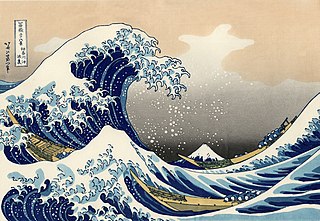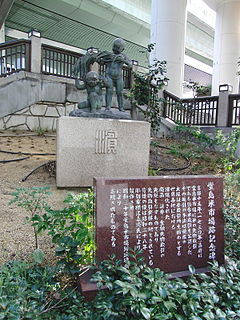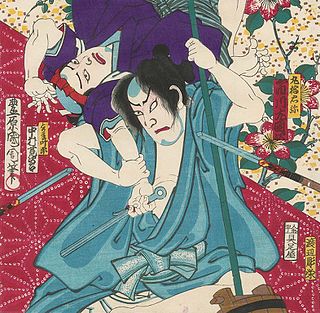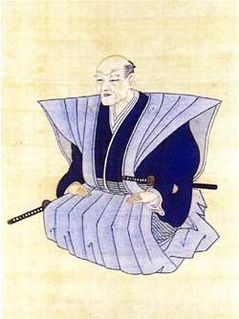
The Edo period or Tokugawa period (徳川時代) is the period between 1603 and 1868 in the history of Japan, when Japanese society was under the rule of the Tokugawa shogunate and the country's 300 regional daimyō. The period was characterized by economic growth, strict social order, isolationist foreign policies, a stable population, "no more wars", and popular enjoyment of arts and culture. The shogunate was officially established in Edo on March 24, 1603, by Tokugawa Ieyasu. The period came to an end with the Meiji Restoration on May 3, 1868, after the fall of Edo.
Dembei was a Japanese castaway who, through Vladimir Atlasov, provided Russia with some of its first knowledge of Japan. He was a merchant clerk accompanying a fleet of "thirty transports laden with goods for Edo," who, along with a number of others, had been caught in a storm; they found their way to Kamchatka, where only Dembei survived, to be found by Atlasov in 1701 or 1702. Despite pleading to be brought back to Japan, Dembei was instead brought to Saint Petersburg, where he told Peter the Great what he could about Japan; he also began teaching the Japanese language to a few Russians, making him the father of Japanese language education in Russia. He was baptized under the name of Gabriel and spent the rest of his life in St. Petersburg.
The Hyōjōsho (評定所), established in 1225 b Hōjō Yasutoki, was a judicial council in Japan.
A tozama daimyō was a daimyō who was considered an outsider by the rulers of Japan. The term came into use in the Kamakura period and continued until the end of the Edo period.
The za were one of the primary types of trade guilds in feudal Japan.

Rice brokers, which rose to power and significance in Osaka and Edo in the Edo period (1603-1867) of Japanese history, were the forerunners to Japan's banking system. The concept actually originally arose in Kyoto several hundred years earlier; the early rice brokers of Kyoto, however, operated somewhat differently, and were ultimately not nearly as powerful or economically influential as the later Osaka system would be.
Abe Tadaaki was a high-ranking government official in Japan under Tokugawa Iemitsu and Ietsuna, the third and fourth Tokugawa Shōgun. As the daimyō of the Oshi Domain in modern-day Saitama Prefecture, with an income of 80,000 koku, Abe was appointed wakadoshiyori in 1633, and rōjū shortly afterwards.
O-Ie Sōdō were noble family disputes within the samurai and aristocratic classes of Japan, particularly during the early Edo period. The most famous is the Date Sōdō, which broke out among the Date family in the 1660s–70s.

The Dōjima Rice Exchange, located in Osaka, was the center of Japan's system of rice brokers, which developed independently and privately in the Edo period and would be seen as the forerunners to a modern banking system. It was first established in 1697, officially sanctioned, sponsored and organized by the shogunate in 1773, reorganized in 1868, and dissolved entirely in 1939, being absorbed into the Government Rice Agency (日本米穀株式会社).
Nabeshima clan is a Japanese samurai kin group.
Chaya Shirōjirō (茶屋四郎次郎) was the name of a series of wealthy and influential Kyoto-based merchants who took part in the red-seal trade licensed under the Tokugawa shogunate. Members of the Chaya family, they were also centrally involved in the country's production and trade in textiles. Along with the Suminokura and Gotō families, the Chaya were one of the top merchant families in Edo period Kyoto.

Marubashi Chūya was a rōnin from Yamagata, and instructor in martial arts and military strategy, most famous for his involvement in the 1651 Keian Uprising which sought to overthrow Japan's Tokugawa shogunate. He is said to have been a man of great strength and good birth whose distaste for the shogunate stemmed primarily from a desire for revenge for the death of his father, killed by the shogunal army at the 1615 siege of Osaka. The identity of his father is not clear, but may have been Chōsokabe Motochika.
Kinokuniya Bunzaemon (紀伊国屋文左衛門) was a Japanese merchant of the Edo period, specializing in citrus, lumber, and salmon, among other goods. He enjoyed the favoritism and protection of shogunal advisor Yanagisawa Yoshiyasu and shogunal minister of finances Ogura Shigehide, and made a sizeable fortune as a result. When these two retired, so did Kinokuniya.
Suminokura Ryōi was a merchant and shipper of Edo period Kyoto.

Zeniya Gohei was a Japanese merchant and engineer in the Edo period.

In feudal Japan, individual military and citizens groups were primarily responsible for self-defense until the unification of Japan by Tokugawa Ieyasu in 1603. During the Edo period (1603–1868), the Tokugawa shogunate formed a centralized feudal government. Samurai warriors who once protected Japan from foreign enemies and fought each other for supremacy became the new police and internal security force. Their new job would be to ensure civil peace, which they accomplished for over 250 years.












